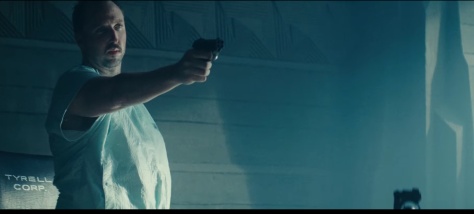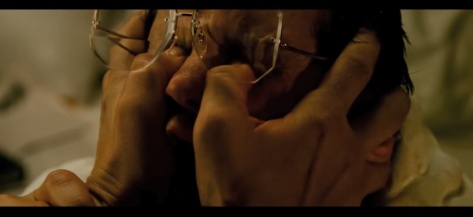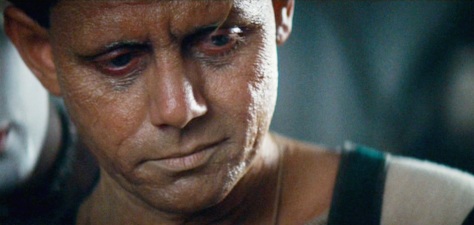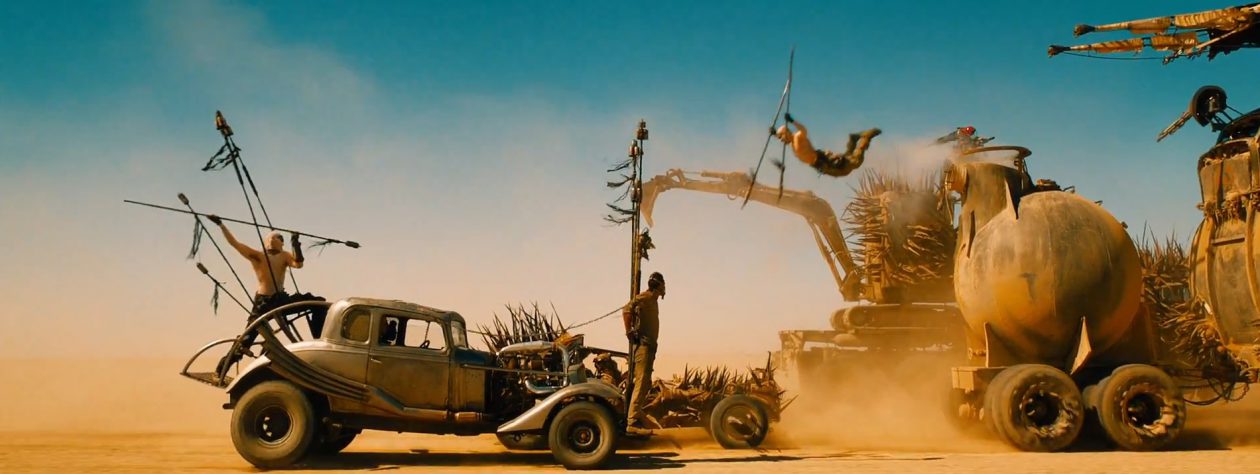This article is part of a mini-series exploring the themes and ideas in Ridley Scott’s Sci-Fi films; for the first part click the link here.
*Spoilers ahead for Alien and Blade Runner*
Blade Runner, based on the seminal novel Do androids dream of electric sheep? is a futuristic world sculpted by the Cold War. By 2019, the Tyrell corporation has created humanoid androids. The androids, called replicants, look like humans and surpass us in intelligence, speed, and strength. Despite their similarities to us, replicants are treated like tools, exploited as slave labour across the solar system and forbidden from coming to Earth. Blade Runner begins after a group of escaped replicants arrive on Earth, which prompts retired Blade Runner, Deckard (Harrison Ford), to return to his old profession and hunt down the replicants.
Alien challenges our position in the universe and our assumptions about intelligent life. In Blade Runner, Ridley Scott turns his gaze from the stars to earth, providing a condemning account of human society from the bottom-up. The replicants of Blade Runner are humanity in the neo-liberal age, dehumanised and robbed of an identity. They are the low-wage worker of today, an expendable commodity sacrificed for the benefit of the elite. The only difference is that replicants do not get a zero-hours contract but only four years to live.
Beyond our present day, the replicants represent ‘the other’ in society. They are the oppressed elements within every nation and culture branded as lesser and promptly exploited. The plight of the replicant parallels the medieval serf, the slave trade and the colonial subject. Despite its futuristic setting Blade Runner biopsies how society quietly exploits those at the bottom while we individuals, just like Deckard, look away.
Replicants: Machine or human?

(Tyrell in all his glory)
Tyrell (Joe Turkel), wearing an imperial purple suit and thick glasses, is the god who underpins Blade Runner‘s society through his knowledge and technological prowess. The escaped replicants’ leader Roy (Rutger Hauer) even address Tyrrel as ‘The god of bio-mechanics’. Tyrrel’s apartment, guarded by an owl, symbol of the wise goddess Athena, is an Olympian temple supported by classical pillars, swathed in golden light from the sinking sun atop the pyramid superstructure witnessed in Blade Runner‘s introduction.
Deckard indulges Tyrell’s request to use the Voigt-Kampff test on Rachel (Sean Young), a supposed human. Deckard confronts Tyrrel after the test stating that Rachel is a replicant and asking, ‘how does she (Rachel) not know what she is?‘. Tyrell’s response is ‘commerce’. To Tyrell, replicants are a faulty product, becoming increasingly unstable as they develop memories and emotions. Rachel is ‘an experiment’ embedded with memories to believe that she is human, making her a more stable product.
Rachel reveals to Deckard that replicants are not just machines, but are parallel to regular humans through her morality and emotions. Ironically, it is Rachel, not any human, who questions Deckard about the moral and philosophical dilemmas of his work, asking him whether he ‘ has ever retired any humans by mistake?‘.
During Deckard’s attempts to chase and kill his replicant targets he begins to see them as increasingly human. At each encounter with an escaped replicant, the story shifts to their point of view, rendering Deckard and the human world around them to be cold, machine-like killers.
Challenging our assumptions

(Our first encounter with Leon)
Leon is the audience’s first introduction to replicants when he is questioned by Dave Holden, another blade runner. Leon is unstable from the beginning, his rage and confusion building until he abruptly shoots Holden in his stomach. Leon’s actions panders to the widespread view of replicants, repeated by Tyrell himself, as a tool that becomes a menace if they run amok. Later on in Blade Runner, Leon toys with Deckard after capturing him, stating to Deckard ‘painful living in fear isn’t it?’. Deckard’s torture by Leon is Leon’s attempt to make another understand his suffering and pain.
Leon creates and later destroys the audience’s perception of replicants though his character arc. Leon transitions from a pyschopathic machine to a slave resisting his masters through the language they taught him, which was violence. Blade Runner uses Leon to challenge our own assumptions about ‘the other’ within society, by underlining how our opinions, just like Deckard’s can be unwittingly formed by convention. When given the chance to speak, the replicants, and ‘the other’ within our own society are exactly like us.
Violent recognition

(Tyrrel’s death)
Both the audience and Deckard slowly begin to recognise the replicants as equal to humans. Then why does Tyrell, god of Blade Runner and father of the replicants still perceive them as below human?
The answer is found in Hegel’s philosophy.
According to Hegel, self-consciousness is not only the recognition of the self, but the recognition of that self by another self-conscious being. In human society, there exists a dominant and subservient consciousness with each recognising the other. This is what Hegel calls the master-slave dialectic. Over time, the slave, having laboured for the master for so long, recognises his position as the inferior and demands the level of superiority enjoyed by the master.
Yet In Hegel’s words ‘Each (consciousness) wants to be securely recognised- has its certainty, but yet not truth.’
The master and the slave both want their identity to be recognised as superior. The master perceives his superiority due to his independence and power over the slave. The slave gains their own sense of superiority through the skill and hardship of their labour. Neither side will compromise and recognise the other as equal, causing as Michel Foucault states, a continual ebb and flow of power between one group and another within society as different identities emerge and conflict.
Tyrrel is the master and the replicants are the slaves. He cannot recognise his own creations as more than human for fear of losing his own position. Tyrrel’s very identity and status in Blade Runner is literally built off the replicants and like the ancient Pharaohs he mimics, Tyrrel cannot be a god without an army of slaves beneath him. Roy’s quest to meet his maker Tyrrel is a struggle for identity, to climb the pyramid and be recognised by the master. Roy finally meets Tyrell, who continues to treat him and the other replicants as objects, calling Roy ‘a prize‘. Roy, disastisfied by Tyrell’s rejection, gauges Tyrrel’s eyes out.
At Blade Runner’s beginning, a superimposed eye blinks and dilates, reflecting the hellish cityscape of 2019 Los Angeles before it. The eyes in Blade Runner represent our own individual struggle with self-consciousness and recognition. The Voight-Kampff test, used to sniff out replicants, revolves around pupil dialation while the sodium orange flare of certain characters’ pupils teases who may be a replicant. After all, it is through our eyes alone that we perceive and recognise world, just like the eye gazing at 2019 Los Angeles. Roy’s gauging of Tyrrel’s eyes is the literal destruction of a worldview that rejects the replicants. Leon, in revenge for Zhora’s death, tries to do the same to Deckard before Rachel intervenes.
What about J.F.Sebastian?

(J.F. being manipulated by Pris)
Perhaps the most unfortunate character in Blade Runner, J.F.Sebastian (J.F.), played by William Sanderson. He is a brilliant genetic designer who helped create the nexus 6 model of replicants. Befriended by replicant Pris (Daryl Hannah), J.F. is manipulated and later killed by Roy as part of his plot to meet Tyrrel. Afflicted by a genetic disorder accelerating his ageing, J.F. is denied ascension to the heavens and life among the solar system. Instead, J.F. dwells alone in a hellish derelict apartment block slowly succumbing to flood water.
J.F. blurs the artificial boundary between replicant and human. Deemed a faulty product, J.F. is valued for his productive capability like the replicants, while his desires are ignored and he is reduced to living alone. J.F’s plight is each our own tragedy, although the humans of Blade Runner are supposed to be superior, J.F. has been exiled and ignored by his fellow man. Strip back the scapegoat of today; be it the banks, the immigrants, or the replicants and we are only valued by society for our economic output while we each in turn dismiss the hardship of others. In a way, we are all replicants without realising it.
Writing about J.F. has made me eager for Blade Runner 2049 . From the glimpses given in the reveal trailer, Blade Runner 2049 will witness the crumbling of the artificial line between replicant and human which J.F. straddles. Whatever happens, I am more excited about Blader Runner 2049 now than when I reviewed the trailer.
By Saul Shimmin


Great piece on Blade Runner – this (plus a visit to the Bradbury Building in LA) has made me decide to rematch this movie over the weekend. Interesting that Ridley Scott had two iconic films out of his first three. I’d say that nothing he’s done since has even come close to Alien and Blade Runner, even though I have liked a lot of his films. Do you think it’s his vision that makes these films, or is it solid screenplays and performances? (I actually think the latter.)
LikeLike
Thank you, its such a compliment that you are going to re-watch Blade Runner now. I must go to the Bradbury Building when I’m in L.A. next, I always forget that the building was not a set!
I think it is Scott’s vision, guided by a decent screenplay behind him which makes these two films iconic. I don’t know if you have heard of Mark Kermode, a film reviewer for the BBC, but he says as much in regards to Alien: Covenant and I have to agree with him. Plus, if you have ever seen The Counsellor you can tell that Scott struggled to really crack Cormac McCarthy’s screenplay, even though the film was not bad visually and Michael Fassbender tried his best in the titular role.
Finally, I think Alien and Blade Runner are so good because of Scott’s inspiration from comics like Heavy Metal and at heart he enjoys creating artistic worlds.
I have linked Mark Kermode’s review of Alien Covenant here if you want to watch it: https://www.youtube.com/watch?v=b79aw9dZLfE
LikeLike
Thanks for the link – yet to see Alien: Covenant so I will not watch for fear of spoilers (I know it’s been out for months). Definitely thought The Counselor was not as bad as people said – still not good, but not terrible – and I think the director’s cut of Kingdom of Heaven is better than Gladiator. But like I said, I think Scott rises or falls based on the script. He’s never made a bad movie, but I don’t think his presence is enough to make a mediocre movie good (whereas I think even Tarantino’s mediocre movies are better than 90% of what’s out there).
I’ll get back to you after some re-watching.
LikeLike
That is fair enough, Alien: Covenant is definitely a Sunday film if you can get it on Netfix or another service. I enjoyed Kingdom of Heaven when I was younger but I must watch the Director’s version so thank you for reminding me!
I have to agree with your comment, Scott has lost a lot of his magic.
LikeLike